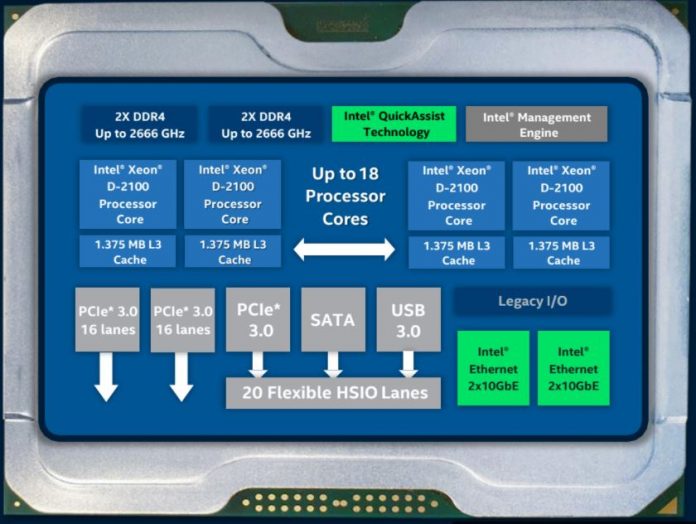Continuing our extensive coverage on the Intel Xeon D series, we wanted to take an opportunity and discuss the evolution of the Intel Xeon D product family since we first covered the Intel Xeon D-1540 and D-1520 launch almost three years ago. From those initial two chips, STH was first to break the SR-IOV bug which was partly responsible for the newer generations of chips. Beyond that simple bug fix, Intel greatly expanded the range, doubling the number of cores, adding more 10GbE and QuickAssist over generations of the Xeon D-1500 series. Now with the Intel Xeon D-2100 series, codenamed “Skylake-D” Intel essentially is on its fifth wave of public Xeon D SKU releases. In this article, we are going to spend some time dissecting the evolution over these five waves.
The First Five Intel Xeon D Waves
We wanted to present a quick view regarding how the Xeon D family has been evolving over time. We are going to present some data broken down calling releases along the same general timeframe (i.e. within a few months) as a wave. We are excluding five SKUs that are branded as the “Pentium D” series released between Q4 2015 and Q3 2016 that had between two and four cores. These five chips are still Broadwell-DE based, but they are branded Pentium so we are going to exclude them.
We are broadly calling these waves as the following:
- Xeon D-1500 Wave 1: Initial release – Q1 2015
- Xeon D-1500 Wave 2: Q4 2015 – Q1 2016
- Xeon D-1500 Wave 3: Q2 2016
- Xeon D-1500 Wave 4: Q3 2017
- Xeon D-2100: Initial release – Q1 2018
The Wave 3 parts were the Xeon D-15×9 series part introduction, so we split these out separately. The newer parts added quad 10GbE support as well as Intel Quick Assist integration which were important features that bring the Xeon D-1500 line into better feature parity with the Intel Atom C3000 and Xeon D-2100 series. That helps customers evaluate a larger range of options when evaluating deployment options.
Expanding Xeon D Family SKUs by Wave
In terms of the raw number of SKUs, we charted how many publicly available SKUs are available by release wave.
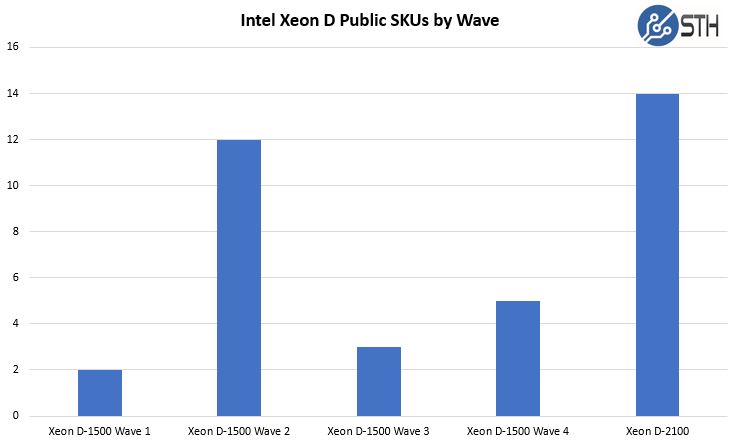
From its humble initial two SKUs, excluding custom SKUs for companies like Facebook, the Intel Xeon D-2100 series shows how much success Intel has had with the platform. On a relative scale, more SKUs were introduced on day 1 of the Intel Xeon D-2100 series than in the first year of the Xeon D-1500 series.
Expanding Xeon D Family Cores by Wave
When one looks at the number of cores per wave, the Intel Xeon D series has greatly expanded the number of cores per wave from the first generation in Q1 2015.
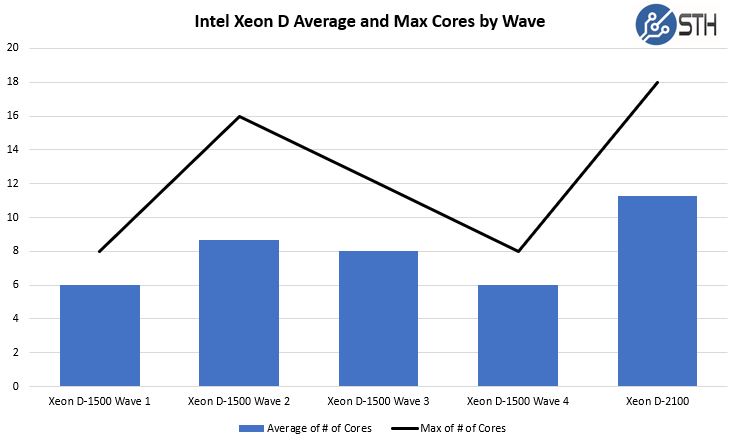
One can also see that while each wave had a minimum of 4 cores, excluding the Pentium D line again, the maximum and average core count of the SKUs in the Xeon D-2100 generation has increased dramatically.
Expanding Xeon D Clock Speed by Wave
Being an embedded part, we generally do not expect the highest clock speeds from the Xeon D series.
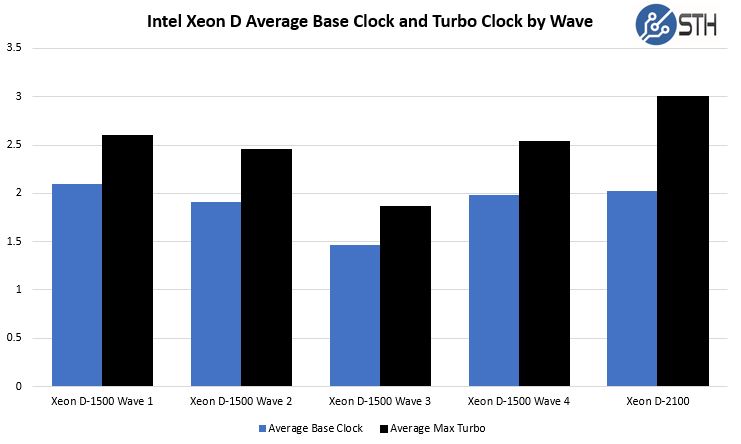
Although the average base clocks have not expanded by a significant margin, the average maximum turbo frequencies have gone up considerably in the Xeon D-2100 series generation. The clock speed ranges that we are seeing have expanded considerably with this new series.
Expanding Xeon D Family TDP by Wave
Along with the core counts, the TDP (in Watts) has increased by quite a bit.
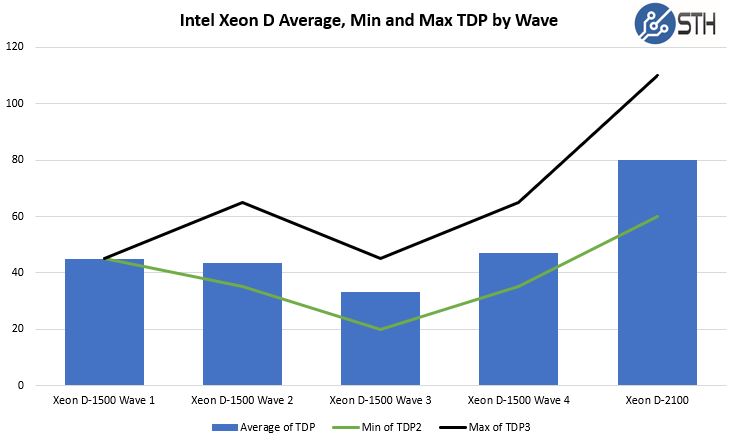
Again, TDP does not translate into power consumption. For example, a 16 core Xeon D-2183IT basic system (4x DDR4 DIMMs and one SATA SSD) can hit over 160W at the wall while the chip has a 100W TDP.
If you look at the cores per generation along with the TDP by generation, you can see that something else is going on. We are going to discuss this as part of the Evolving Platform Features section below.
Expanding Xeon D Family Pricing by Wave
With a bigger platform and more cores, as one may expect, the Intel Xeon D-2100 series also has a vastly expanded recommended customer price (RCP) range in dollars.
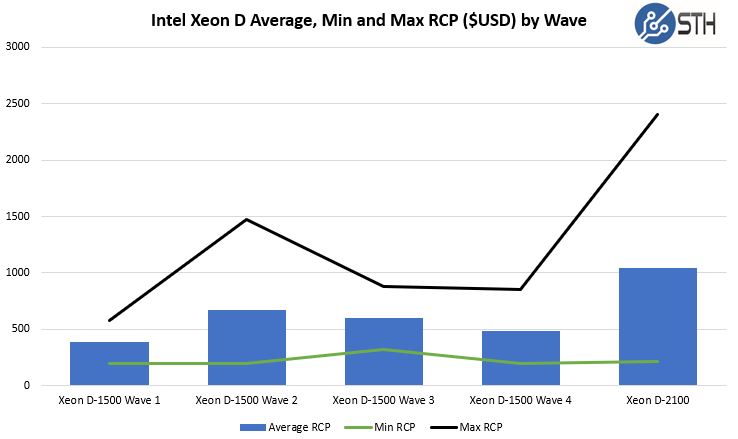
This mirrors a general trend we have seen in the Skylake generation of CPUs from Intel. While we see some core and performance gains, pricing has gone up a lot over Broadwell generation parts.
Evolving Platform Features
One thing is for sure with the Intel Xeon D-2100 generation: the platform expansion capabilities are far greater than the previous generation. One can use twice as many DIMMs and larger capacity DIMMs. There are 32x PCIe 3.0 lanes plus up to 20x HSIO lanes versus 24 PCIe 3.0 lanes plus 8 PCIe 2.0 lanes in the first generation. Other features such as SATA III, USB 3.0, and QuickAssist options are higher-end on the newest generation as well.
We have been making a big deal about the inclusion of the Lewisburg PCH IP in the new Intel Xeon D-2100 series. One of the frankly great features of the Xeon D series is that Intel uses platform controller hub (PCH) features based on its other lines. The Intel Xeon D-1500 series, for example, only had 6x SATA III lanes. That is because it used the Intel C220 series PCH IP, also found on the Intel Xeon E3-1200 and consumer platforms. Specifically, Intel used the Lynx Point (circa 2013) IP. That meant that many OSes already had the necessary drivers for its SATA and USB ports for example.

The other implication is that by using that IP, Intel was able to keep power consumption relatively low. An Intel C224 PCH chip is rated at 4.1W TDP. The disadvantage is that the PCH IP was designed for lower-end platforms, hence the limited functionality. Intel made a major effort to upgrade platform connectivity.
By utilizing Lewisburg PCH IP, Intel has features such as 4x 10GbE ports, access to QuickAssist integration, up to 14x SATA III ports, and additional downstream PCIe connectivity.
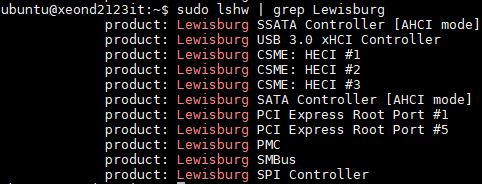
The flip side to this additional feature set is that the discrete PCH for Lewisburg has a much higher TDP range from 15-26W depending on the SKU.
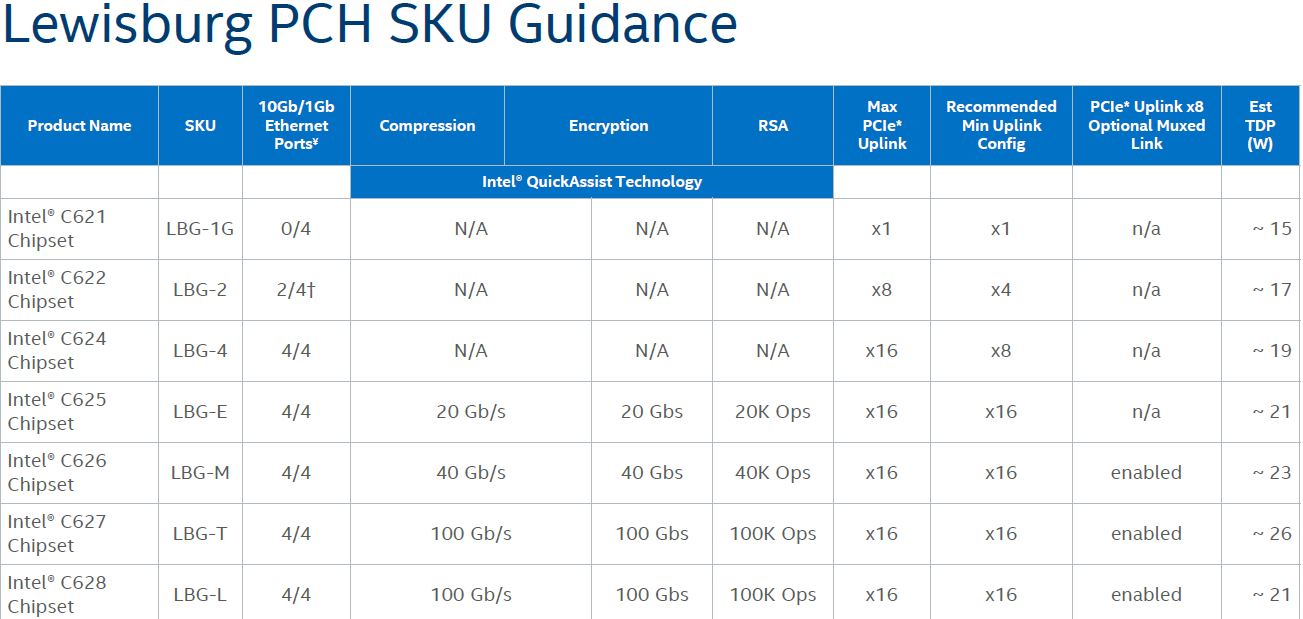
We bring this up because we are going to see significantly higher power consumption figures with the new Intel Xeon D-2100 series and this is one clear area where we see there is potential for additional power consumption.
Confirming the Intel Xeon D-2100 Series is a SoC
We asked Intel whether the Xeon D-2100 series is a SoC or a multi-chip package since there has been some question whether there was one die in the new Xeon D package or multiple.
Update: To clarify what was asked, here is the question posed in the e-mail to Intel:
Any official word from Intel if the Xeon D-2100 series is a multi-chip module or a SoC that combines Xeon Scalable cores plus a Lewisburg PCH on a single piece of silicon.
Here is the response we got from Intel:
The Xeon D-2100 is a purpose-built, system-on-a-chip (SOC) designed to deliver great energy-efficient performance and hardware-enhanced security and virtualization capabilities with a compact form-factor. It brings the architectural innovations of the Xeon Scalable platform into a single socket BGA processor for lower-power, high-density solutions, integrating essential network, security and acceleration capabilities. Xeon D-2100 builds upon the lineage of the Xeon Scalable platform and its mesh architecture and related datacenter class chipsets, providing customers with new dedicated integration choices to complement the added flexibility and performance scalability available with the multiple socket configurations supported with Xeon Scalable processors.
As such, it sounds like the chip is a SoC that integrates both Xeon Scalable Skylake Server cores along with Lewisburg PCH IP into a single chip.
Performance on Embedded SKUs
We wanted to take a quick look at the performance of embedded SKUs. We took a sampling of the Intel Atom C3000, Xeon D-1500, and Xeon D-2100 series parts both at 4 core and 16 core parts to show how Intel’s current offerings stack up. Four cores are the minimum for the Xeon D-1500 and Xeon D-2100 series. Sixteen cores are the maximum core count for the Xeon D-1500 series, the Atom C3000 series and the volume processor Xeon D-2100 series.
One benchmark we typically use for this is our Linux kernel compile benchmark. This touches a decent amount of the total system performance factors and is something many Linux admins and developers have the first-hand experience with.
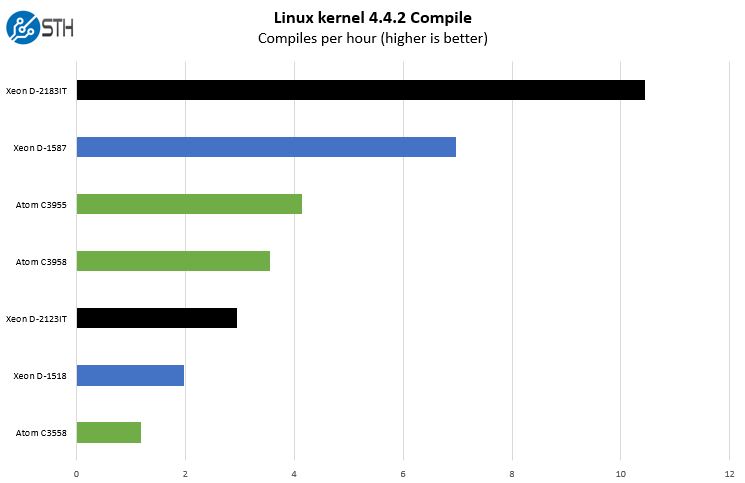
As you can see, the higher power and thermal envelopes, higher clock speeds, additional memory bandwidth, and more robust cache structures allow the Xeon D-2100 series parts to pull ahead. At the same time, this chart shows that we have clear overlap in segments of the market by Intel’s three main embedded offerings.
Here is a good example of non-QAT accelerated OpenSSL Verify tests on the same set of CPUs:
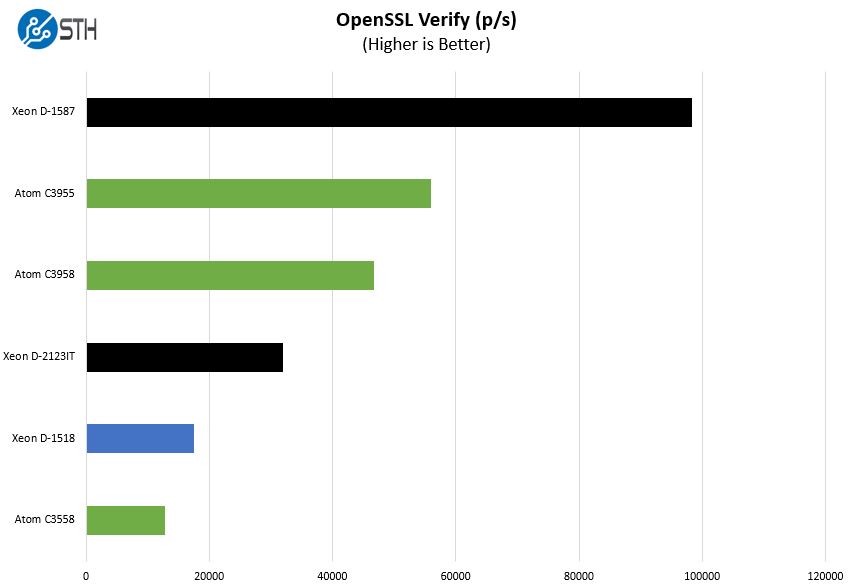
We see generally the same pattern as we saw in our previous results.
To highlight the AVX-512 and clock speed impacts of the new generation, we take the 16 core parts in each generation through our GROMACS STH Small test case.
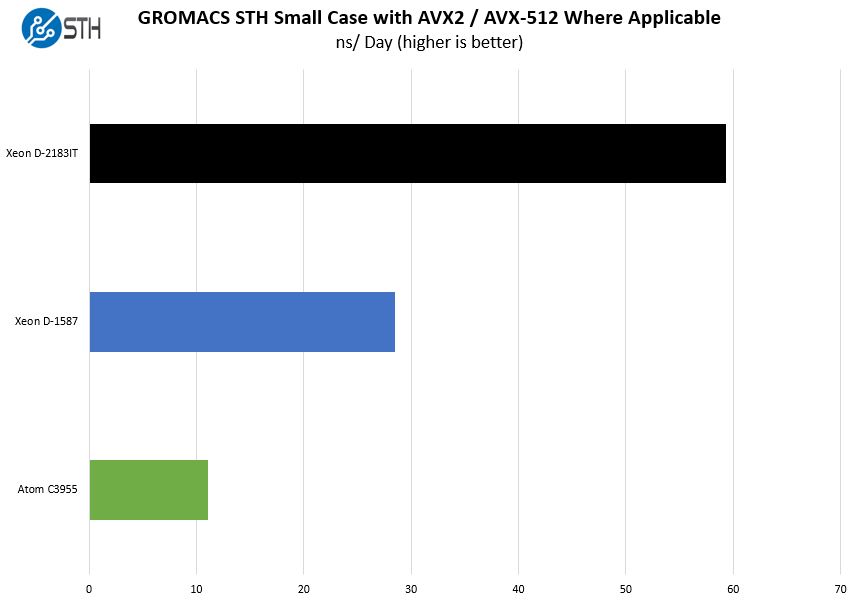
Here the additional thermal headroom and AVX-512 help the Xeon D-2183IT to a clear performance victory, and it is not even close.
We pulled these from our data set, but this shows just how much these product lines overlap. At the same time, it clearly shows how the new Xeon D-2100 series can have significantly higher performance. We suggest a portion of the enormous delta in the two 16-core/ 32-thread Xeon D parts is due to the increased clock speeds. There is a single digit IPC increase from the generationally updated cores. The new cores also have more cache than in the Broadwell-DE generation. Finally, the new Xeon D-2100 series generation essentially has twice as much memory bandwidth as the D-1500 generation. Those factors have tangible performance benefits.
While it is a more robust platform, more performance can mean more power consumption which we recorded during oru testing.
Power Consumption on Embedded SKUs
While performance is one side of the equation, and it is much higher with the Xeon D-2100 series, the other side is power consumption. We have been talking generally about just how much more power we are seeing the new Xeon D-2100 series use. We wanted to take a look at this in terms of the same four and sixteen core CPUs. The grey bars are maximum power consumption we saw during our test suite at a platform level (single Intel DC S3700 400GB SSD and 4x 32GB DDR4 RDIMMs.)
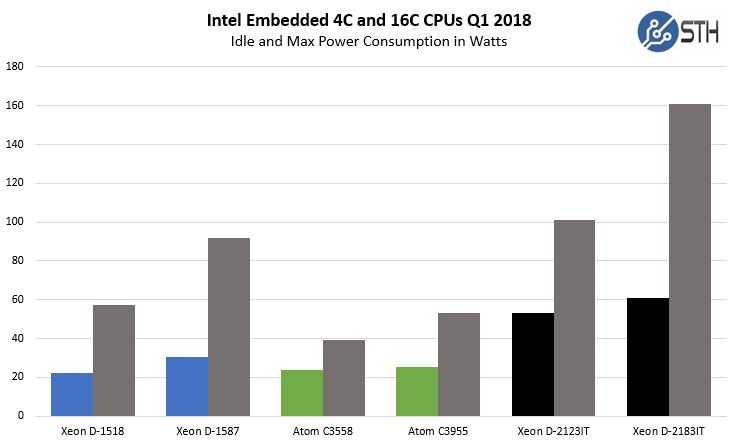
Here is the takeaway if nothing else: the Intel Xeon D-2100 series essentially uses more power at idle than the Intel Atom C3000 series at full speed. You can also see just how much more power we see the new generation use versus the Xeon D-1500 series. That is significant. The additional thermal dissipation means larger heatsinks for the D-2100 series. In turn, it makes it more difficult to have smaller form factors. Those same small form factors are a key selling point of the Xeon D family.
Final Words
There are features such as networking and QuickAssist Technology that are important and that we did not cover in-depth here. At the same time, there is a clear trend emerging with the Intel Xeon D-2100 series being faster, having more expandability, using more power, needing larger form factors, and costing more than the Xeon D-1500 generations. That is a primary reason we see the Xeon D-2100 series as complementary to the Xeon D-1500 rather than a direct replacement. For those looking at solutions with larger cores and L3 cache, the smallest form factors and the lowest power, e.g. for a lab cluster, the Intel Xeon D-1500 still makes a lot of sense.
Naturally, one may be wondering about AMD EPYC, Xeon E3, Atom C2000 series, and Xeon Scalable in relation to these chips. We have posted a bit on this in our forums and have plenty of data we are collecting for future pieces.
Check out our Intel Xeon D-2100 launch coverage central for information on the newest generation of chips.

